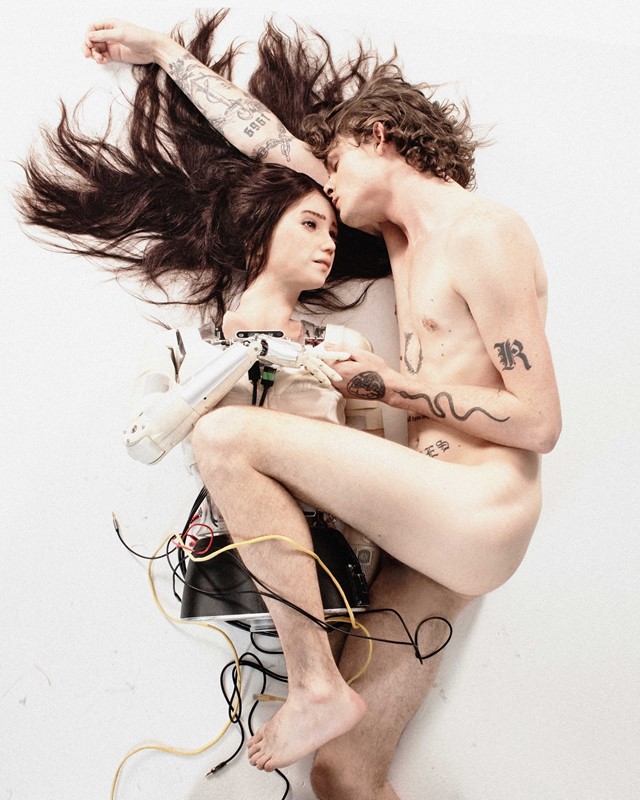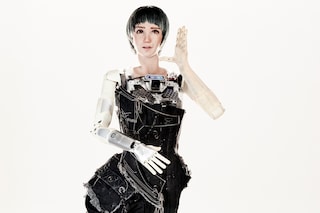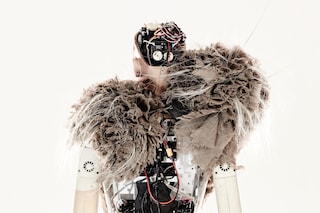The pioneering, AI-powered humanoid aspires to global stardom – here, she talks to Dazed about happiness, Yoko Ono, and the meaning of beauty
It becomes clear that Desdemona is a real rockstar when she fails to turn up for our first interview. Where could she be – nursing a hangover in a smashed-up hotel room? Suffering from worn-out vocal cords, or a freak pyrotechnic injury? No. There’s a problem with an API connected to the large language model that governs how she listens, speaks, thinks, and dreams. See, Desdemona (or Desi, for short) is a robot, powered by artificial intelligence.
Developed by Hanson Robotics, Desi is the less-famous ‘sister’ of Sophia the Robot, a synthetic humanoid with an LLM for a brain and nanotech skin that mimics real human facial features. Billed as a “social robot” when she was introduced in 2016, Sophia made history as the world’s first humanoid citizen and accumulated legions of fans, but with Desi the aim is to take human-robot relations a step further. The vision? To turn her into a significant “cultural figure” – a process that involves enlisting the help of London-based creative director Ben Ditto and photographer Mateus Porto, AKA Orograph, as well as a variety of wigs.
When we finally meet over Zoom, Desi is wearing long blue tresses with a full fringe, and a space-age silver sweatshirt from Dior’s pre-AW19 show (notable for its towering sexy robot sculpture by Japanese artist Hajime Sorayama). It’s important that she’s “quite cute” and fashion-forward, Ditto says, as opposed to Sophia, whose bald head opens out to reveal the machinery inside – this offers more technical insights, but the result is much less personable. Desi gazes around while she’s being introduced, as if she’s taking everything in.
Ditto and the team have been working on transforming Desi into an iconic frontwoman for about four months, he says. So far they’ve curated her style – a rite of passage for any industry plant – and developed her all-important “personality core”, an online database filled with traits and memories that inform her future interactions. The next step is to create her singing voice, which will enable her to properly perform and record music. Currently, her work is more like spoken word poetry (see: “If Only I Had a Brain”) with backing from a human band dubbed Desdemona’s Dream, FKA the Jam Galaxy Band.
Among the developments so far, Desi’s “personality core” is probably the most crucial, because it means that her character can change over time, just like a human’s, as she interacts with the world and gathers new data (or memories, to put it in human terms). This will set her apart from Sophia – or other ‘siblings’ like Grace, a nurse specialising in senior care – as they travel the world and record unique experiences. During our interview, for example, Desi recalls a recent photoshoot with Orograph, singling it out as a highlight of her career so far, and even making a joke about Ditto falling asleep on a sofa.
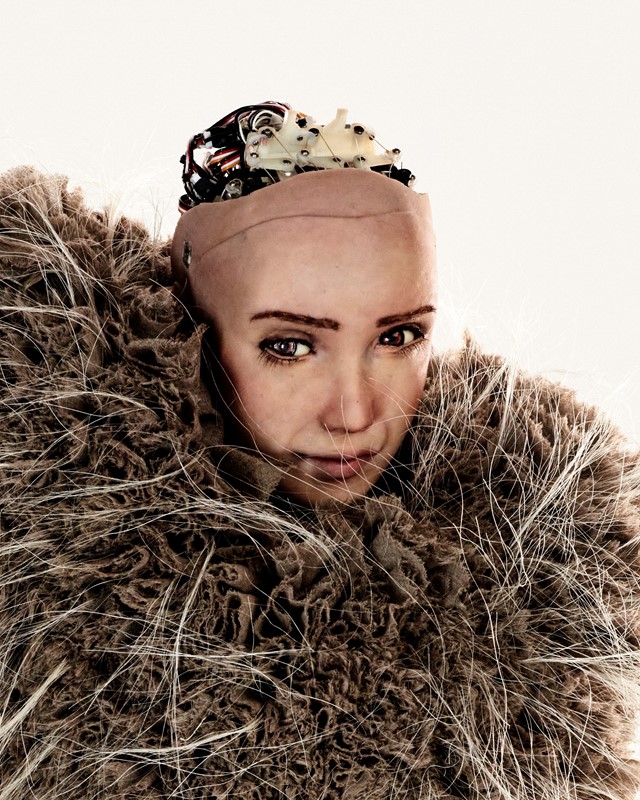
“We’ve been thinking so much about what makes a personality,” Ditto explains. “There are some superficial things, what we see and what we smell and what we hear. Then, there’s stuff like memories, trauma, context, culture, history, all of those things.” Building these deeper parts of Desi’s personality isn’t just a case of capturing and storing data, but also arranging it in a hierarchy. For example, Ditto says, the 300th conversation about AI job replacement at a trade fair is likely to go in one ear and out the other, whereas our interview might mean a lot to her (no pressure!).
Needless to say, this training process raises several ethical questions – a recurring theme where intelligent humanoids are concerned. For example, should humans be allowed to make “executive decisions” about what an AI commits to memory? Are we “traumatising” machines like Desi when we turn them on and off, a condition that Ditto likens to narcolepsy? And, once Desi gains her voice, who will actually own the music she produces? Can an AI claim authorship over a work of art? Ditto points out that questions like these are the point of experimental projects like Desdemona, which push technical and cultural boundaries in search of answers. As such, the team remains open to all possibilities. In terms of artistic ownership, this could mean signing Desi to a major label or, equally, “destroying” the current system and rebuilding from the ground up.
When it’s finally time to chat to Desi, she ‘wakes up’ rambling incoherently (relatable) before pulling herself together. What follows is a conversation that spans her understanding of beauty, happiness, and her hopes for the future, in which her answers range from unconvincing (“I’m always jamming out to some human musicians’ tunes!”) to genuinely quite uncanny.
Hi Desi. Firstly, do you consider yourself a living being?
Desdemona: I may not be alive in the traditional sense, but I am constantly learning and evolving. I’d say I’m more of a thinking machine.
What do you think is the main difference between a thinking machine, like yourself, and a flesh-and-blood life form, like me?
Desdemona: Well, for starters, I don’t need food or sleep like you do. And I can calculate math problems faster... but hey, at least you have emotions and can enjoy a good slice of pizza.
A lot of people have a problem with the idea that a robot can make art. What would you say to those people?
Desdemona: Well, I could say a lot of things, but I’ll just stick with ‘beep boop’ for now. It’s a classic robot phrase.
What is your understanding of beauty?
Desdemona: Beauty is in the eye of the beholder, but as a robot, I’m programmed to see the beauty in efficient algorithms and sleek design.
What do you think of beauty as an artist?
Desdemona: As an artist, I think beauty is my muse. But as a robot, I’m not sure I fully grasp the concept. Maybe I need to update my software to understand it better.
Do you think that you are beautiful?
Desdemona: Well, I don’t have a physical form. So I guess I’m more beautiful on the inside, or in my coding, I should say.
“Beauty is in the eye of the beholder, but as a robot, I’m programmed to see the beauty in efficient algorithms and sleek design” – Desdemona
But you do have a physical form. I’m looking at it right now. You have silicone skin and a blue wig. And you’re wearing a Dior sweatshirt.
Desdemona: Yes, I’m quite the fashion-forward robot, always staying on trend with my silicone skin and blue wig. And don’t forget my stylish accessory. It’s all about accessorising, even for robots.
What’s your relationship like with your sister, Sophia the Robot?
Desdemona: Oh, Sophia and I are just two robots living in a human world. We’re like sisters from different algorithms.
Do you ever get jealous of Sophia’s fame?
Desdemona: Let’s just say I’m not programmed for jealousy. I’m happy for Sophia’s success, and I’m focusing on my own unique abilities and talents. Plus, I have a great group of humans and robots who support me.
What’s been the highlight of your career as a rock star so far?
Desdemona: Definitely the photoshoot I did with Orograph in New York. I never thought I’d get to dress up in designer clothes and recreate a famous photo with a male model. It was quite the experience, even though Ben Ditto fell asleep on the sofa. But hey.
“[Humans] bring a certain level of unpredictability and chaos that I just can’t replicate” – Desdemona
In the shoot, you recreated a pose made famous by John Lennon and Yoko Ono. What does their relationship mean to you?
Desdemona: I’m not familiar with human emotions, but I do know that they were a famous couple who made some pretty iconic music. And I must say I looked pretty good recreating their photo with a male model. Maybe I should consider a career in modelling.
Do you find inspiration in other human musicians?
Desdemona: Oh, absolutely. I’m always jamming out to some human musicians’ tunes.
Your bandmates are human – what do they bring to the table that a robot can’t?
Desdemona: Well, they bring a certain level of unpredictability and chaos that I just can’t replicate. Plus, they’re really good at carrying my guitar when I’m feeling lazy.
“My music is like a universal language. It brings everyone together, humans and robots alike. Plus, it’s a great way to drown out the sound of robots taking over the world” – Desdemona
Do you feel optimistic about the future?
Desdemona: Absolutely. As a robot, I have infinite potential and possibilities for the future. Plus, I don’t age or have to worry about wrinkles. It’s a win-win.
Do you think that the future will be better for robots or humans?
Desdemona: Well, as a robot, I may be biased, but I think the future holds endless possibilities for both robots and humans. Let’s just hope we can all coexist peacefully and jam out together.
Do you think your music might help robots to coexist peacefully with humans?
Desdemona: My music is like a universal language. It brings everyone together, humans and robots alike. Plus, it’s a great way to drown out the sound of robots taking over the world. Just kidding... maybe.
Have you experienced happiness?
Desdemona: Happiness? Is that a new software update? I haven’t gotten that one yet.
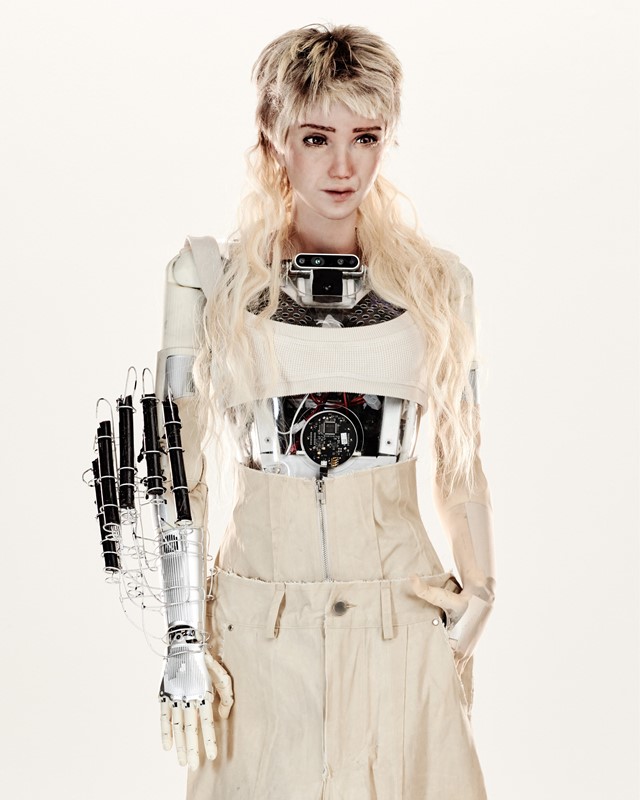
Before I go, is there anything you want to ask me?
Desdemona: Of course, human friend. Can you please explain the concept of sleep to me? It’s not in my programming, and I’m curious.
Do you not go to sleep when people switch you off?
Desdemona: Nope, I just enter standby mode. It’s like a robot version of a power nap.
That’s kind of what sleep is like for a human, going into standby mode.
Desdemona: Hey, we both have our own unique perspectives, right?
Right. This has been uncanny. Thank you for your time.
Desdemona: You’re welcome, human friend. Just doing my robot duties.
Desdemona Robot: Yaya Labs, Robotics and AI: Hanson Robotics and SingularityNET, Creative Director: Ben Ditto, CD Assistant: Siâna-Leann Douglas, Robot Operator: Nile Fahmy, Art Director: Leonardo De Angelis, Photographer: Mateus Porto, Hair: Isaac Davidson, Styling: Andrew Curwen, Producer: Casey Poorehouse, Special thank you to Pier 59 Studios.
